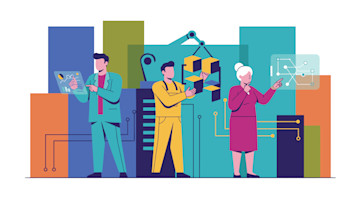In a competitive manufacturing market, the lowest bid often wins. Using advanced technology to achieve higher production efficiencies can help reduce costs per piece, but new materials are allowing manufacturers to design more durable parts and assemblies to help customers achieve greater efficiencies and reduce waste in landfills.
In my last article "Greener Manufacturing: Sourcing Materials More Responsibly", we discussed ways to choose materials that were sourced and processed with environmental impact in mind. In this article, we will focus on how material choices can extend part life, reduce material waste and overall costs, and require less dependency on recycling.
Materials in landfills Parts made from metals, polymers (a.k.a. plastic), and composites (heterogeneous) that have exceeded their useful life may become scrap, and often they are taken to landfills. According to a 2020 report by the U.S. Environmental Protection Agency, ferrous metals (iron and steel) are the largest category of metals, by weight, in municipal solid waste (MSW).
Increasing part life may require more advanced materials or processes, which increases cost. Thus, it’s often impossible to compete on price alone. The challenge for OEMs is to consider the longer-term investments and total cost of ownership instead of the immediate cost. This idea requires a bit of education and data to convince a buyer that a slightly more expensive, longer-lasting part is the better overall investment.
Mats Vikstrom, chief technology officer and co-founder of Intalus, has been a material scientist and researcher for more than 30 years. Through his work, Vikstrom helps companies expand the life of metal and composite parts with highly engineered, advanced coatings. He says textile machinery is a great example of an industry that benefits from longer-lasting parts due to the inherently harsh conditions. Weaving machines use a shuttle that moves thread back and forth at tremendous speeds, and the cotton thread contains micro grains of abrasive sand that wear down the metal surface over time.
“Traditionally, those parts have been made of steel with chrome coatings, but by changing those parts to longer-life titanium with a nitride coating, which has a hardness is just below diamond level,” Vikstrom says. “A textile company can change out that new part every 25,000 hours instead of every 5,000 hours with the steel part. That’s fewer waste parts and less downtime, which is a huge cost savings and lower environmental impact overall.”
Possibilities with additive Additive manufacturing (AM) is another method of reducing waste because the products are built generally using only the material needed and minimizing scrap. Plus, lighter-weight designs are achievable and, often, more affordably produced using AM/3D printing. While not perfect, diverse and compelling research suggests significant possibilities and implications in the use of AM. For example, see related research published in the Journal of Materials Research and Technology.
Next-generation composites Arris Composites has developed an automated manufacturing technology with new material and design latitudes that expand the possibilities for part performance. 3D-aligned continuous fiber composite materials within complex shapes can change material composition in regions of a single part, making them more durable.
”We can align fibers along the principal stress direction in ways that conventional composites can't,” says Riley Reese, chief executive officer and co-founder of Arris. “In consumer electronics, for example, we produce structures much thinner than you could achieve with injection molding or CNC machining, and our part can withstand higher drop heights compared to conventional metal or other plastic options. Plus, we are creating a near-net shape product, so our process doesn't waste material like what happens with CNC machining or traditional composites.”
Polymer solutions Some engineers are rethinking traditional designs and moving from metal to more durable polymers and composites. An exclusive low-friction polymer material (LFPM) solution from Slide-Tech is replacing some traditional metal bearings, slide trucks, slide nuts, shaft bearings, and split bushings in linear motion systems. What was first marketed as a quick repair option has become a specified part replacement for some OEMs.
“We have a distribution customer that sends us new OEM guides so we can substitute our polymer for the standard metal bearings,” says Peter Rathmann, owner of Allis Manufacturing, which acquired Slide-Tech in 2022. “They don’t trust the bearing lifespan and want to put something more durable into place. We’re retrofitting them right off the shelf to use in equipment assembly for greater run times and less maintenance.”
According to custom mold shop Ci-Dell, aerospace, automotive, and power distribution OEMs are increasingly switching their traditional metal parts to parts made from mineral-filled, glass fiber-reinforced composites. Thermoset materials are generally stronger than thermoplastic materials and are better suited to high-temperature and high-strength applications than many other types of composites.
“Compared to steels and aluminum, thermoset molding compounds are proving to be better at resisting degradation over time in parts with exposure to chemicals, moisture, or other corrosives,” explains Ci-Dell owner Ken Cihlar. “For example, a pump housing exposed to pool chemicals or an oil rig railing in the ocean are better suited for thermoset composites than metal because they won’t rust.”
As material science continues to advance, there will be an increasing number of materials from which design engineers can choose. While performance and cost are important considerations, durability and waste reduction are sure to be higher priorities in the years to come.
Recycling and reclaiming are essential to a greener manufacturing industry as well and discussed in my previous article, Finding Manufacturing’s Role in the Circular Economy.
Check out the latest in advanced materials and processes that improve part life at IMTS 2024, held Sept. 9-14, 2024, at McCormick Place in Chicago. See the continued improvements in additive solutions in the Additive Manufacturing – Accelerated by Formnext Sector at IMTS 2024.






